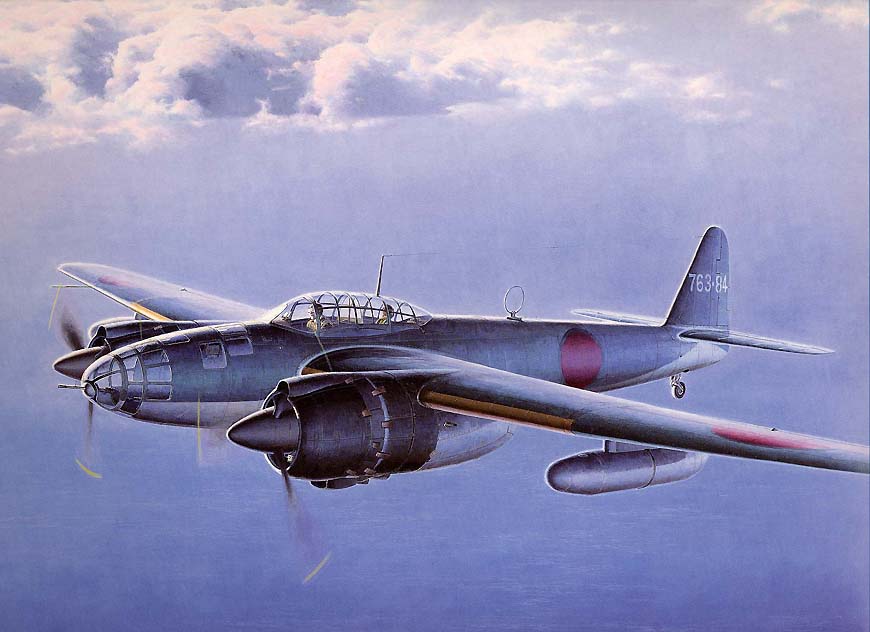|
Air Power |
The Allied forces facing Japan in the Pacific War had a number of highly effective fast twin-engined light and medium bombers to choose from. Japan, however, lacked an equivalent aircraft until 1944, the year the Army's Ki-67 Hiryu first saw combat and the Navy received its first examples of the P1Y1 Ginga (Milky Way). Designed by the Yokosuka Naval Air Technical Arsenal and built primarily by Nakajima (with some examples made by Kawanishi), the sparkling performance of the prototype led the Navy to order it into production almost immediately. But the serviceability and reliability of the Ginga right off the production line was very low; thus, it wasn't formally accepted by the Navy until October 1944, and it saw no combat until the Okinawan campaign in 1945.
The Yokosuka Arsenal in 1940 began development of the Ginga to fulfill the requirements of a specification calling for a fast twin-engined bomber capable of making dive and torpedo bombing attacks. The specification was clearly influenced by the Junkers Ju 88 which was just entering combat in Europe, but the aircraft created by Tadanao Mitsuzi and Masao Yamana was no mere copy of the Ju 88. It was a cleanly designed twin-engined airplane with mid-mounted wings on a narrow fuselage of circular cross-section. The proposed engines were twin Nakajima Homare eighteen-cylinder air-cooled radials, which were then in the design stage. With a pair of Homares, the new aircraft was expected to reach a top speed of 345 mph at altitude, and as range was considered all-important for a Japanese land-based bomber, eight protected and six unprotected fuel tanks with a total capacity of 1,218 gallons were to be installed in the wings. Provision was also made for two underwing 48-gallon drop tanks, and oil tanks in each engine nacelle. But armor was restricted to a single 20mm plate behind the pilot's head. The proposed defensive armament was to be just two guns, one in the nose and the other in a flexible dorsal mount; by European/American standards, this was wholly inadequate, and the plane was expected to rely on its speed and maneuverability to escape interceptors. As for the offensive payload, one 1,764-lb. torpedo was to be carried semi-internally under the fuselage, or else two 1,102-lb. bombs were to be carried in the ventral bomb bay.
While the design of the Y-20, as the Imperial Navy designated the prototype, was proceeding, actual production of the new aircraft was assigned to Nakajima. When production of the G3M3 bomber (Nell) terminated as scheduled in February 1943 with the last five examples being rolled out of the Koizumi plant, the G3M3 assembly lines were swiftly dismantled to allow the Y-20 to be built in quantity. The first prototype, powered by a brace of Nakajima Homare 11 engines rated at 1,820 horsepower and driving three-bladed constant-speed propellers, was completed in August 1943. It made its first flight shortly afterward. Both the company's and the Navy's test pilots were enthusiastic about the new plane's high turn of speed and ease of handling in the air, but the ground crews-even the expert mechanics from Nakajima-complained bitterly about the Y-20's troublesome hydraulics and unreliable engines. Even with the favorable conditions obtained during the flight-testing program, the Y-20 was cursed with horrendous maintenance difficulties, and although ordered into production before all six prototypes were built and flown, its formal service acceptance was delayed for thirteen months. Thus, 453 examples were built in all that time, yet they sat idly by while the war situation deteriorated alarmingly for Japan.
During that thirteen-month period, a number of changes and simplifications were made on the assembly lines. The former curved windscreen was replaced by a flatter one incorporating a bulletproof panel, flat-headed rivets were used in the fuselage's construction instead of flush rivets, and the former collector-ring exhaust stacks were replaced by individual stacks to give thrust augmentation. Later production examples also differed from the prototype by having the slightly more powerful Homare 12 (1,825 hp) replacing the Homare 11 (the three-bladed propellers were retained throughout the craft's service life), and by fitting a fixed tailwheel in place of the former retractable one. The prototype Y-20 had a single 7.7mm machine gun in the nose and a 20mm cannon in the dorsal position, but production aircraft had a 20mm gun in the nose, and later, single or twin 13mm machine guns replaced the slow-firing 20mm cannon in the dorsal mount. Very late production aircraft, towards the end of the war, had air-to-surface search radar, and it was also planned to use the P1Y as a mother craft for the Ohka flying bomb, as will be related below.
Finally in October 1944, the Navy gave its blessing to the Y-20, and it became formally known as the P1Y1 Navy Bomber Ginga Model 11
Specifications:
Design Bureau: Dai-Ichi Kaigun Koku Gijitsusho
Manufacturer: Nakajima
Type: twin-engined medium bomber
Crew: three
Engine: two Nakajima NK9C Homare 11 eighteen-cylinder air-cooled radial engines, each rated at 1,820 hp
Allied Code Name: Frances
Performance :
cruising speed: 230 mph
Max speed: 340 mph at 19,355 feet
Max range: 3,338 miles
Service Ceiling: 30,840 feet
Dimensions:
wingspan: 65 feet, 7 inches
length: 49 feet, 2.5 inches
height: 14 feet, 1 inch
Weights: empty 16,017 lbs / loaded 23,149 lbs / maximum 29,762 lbs
Armaments:
one flexible 20-mm Type 99 cannon mounted in the nose;
one flexible rearward-firing 20-mm Type 99 cannon mounted in rear cockpit;
one 1,764 lb torpedo or up to 2,205 lbs of bombs 




Note marking on the plane. (must have been a capture)
All information and photos Copyright of their respective websites


